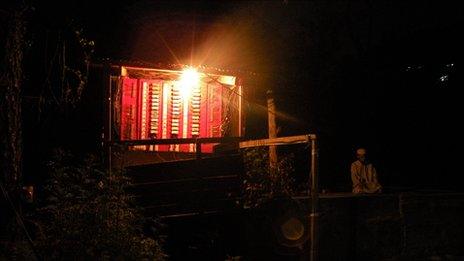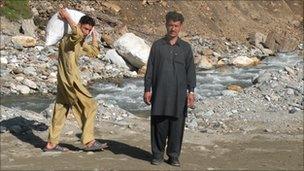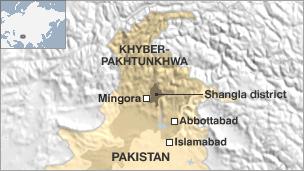Pakistan floods turned back clock and turned off lights
- Published

Prayers outside one of the few hydropower generators in Shangla still working
Once the envy of the rest of Pakistan, Shangla district in the north had all the cheap electricity its inhabitants could consume, thanks to the ingenuity of local entrepreneurs who harnessed the power of rivers.
But the devastating monsoon floods which hit the country in August have swept away the infrastructure, plunging Shangla into darkness and turning back the clock many decades, finds the BBC's M Ilyas Khan.
"This is where my furniture factory stood. It was about 30ft above the river, and several dozen feet away from it," says Farmanullah, a businessman in northern Pakistan's Khyber-Pakhtunkhwa province.
But for about 200ft (60m) on either side of where he is standing, in the village of Damorai in Shangla district, it's now a vast bed of rocks and boulders.

Businessman Farmanullah amid the rubble where his furniture factory once stood
A bridge that once lay across the riverbed now begins and ends in the middle of it, looking sadly out of place.
"I can tell the location of my shop from the bridge," the 32-year-old says. "There was an entire market here. It is gone, and the land on which it was built is gone."
Further down the Shahpur valley, near Kuz Kana village, the river torrent destroyed nearly 3km (1.9 miles) of road, as well as nearby houses and agricultural fields.
Not a glimmer
But those lucky enough to still have a shelter have been deprived of electricity.
As night descends on this mountainous district, the hills become pyramids of darkness, rising against an unusually bright sky.
Apart from the stars, there is not a glimmer of light in the entire valley.
This has not happened here in 20 years or so, residents say.
In 1977 local entrepreneurs harnessed the power of the area's abundant rivers and streams to generate cheap electric power.
By the late 1980s, most valleys in Shangla district had a dependable power supply of their own, unlike the rest of Pakistan, where power outages had by then become the norm.
There were more than 200 small hydro-power generators installed along mountain streams in all the inhabited valleys of the district.
Officials say nearly 150 of them have been lost to floods.
And replacing them will take years, says Saeedullah Khan, a resident of Shahpur village, after which the valley is named.

Mr Khan owned a 50 kilovolt-ampere (kva) generator, which supplied electricity to 300 homes, as well as a couple of saw mills and a handful of agricultural implement manufacturers, who depended on electric welding.
Now he looks at the sea of randomly tossed rocks and boulders, and says he cannot pinpoint the exact location of his lost generator.
"It will cost about two million rupees ($23,300; £14,700) to build a new one, given the amount of land preparation it will need, in addition to issues of land ownership, as my own land has been swept away," he says.
Besides, Mr Khan will first need to rebuild his house, which was also washed away by flash floods, forcing his family to take shelter with relatives.
Syed Anwar Shah, a resident of Lilaunai valley, owns one of Shangla district's few hydropower generators that are still functional.
The Shah family is considered a pioneer in what experts here call micro-hydropower technology.
Exodus
In the 1970s his father, Aab-e-Hayat, generated electricity from a stream using a wooden turbine he had himself designed.
A few years later the family had designed and installed dozens of generators in Shangla district.

Saw-mill owner Syed Anwar Shah (L) is one of the lucky few to still have a generator
"It completely changed people's lifestyle and their economy. Students could study for longer hours in the night," says Mr Shah.
"Water heating became efficient. Television brought the world to people's bedrooms. And refrigeration changed the entire concept of domestic and commercial life."
Suddenly it seems the clock has turned back to 1970s.
Furniture factories and steel-works have come to a halt; cold drinks and ice cream cups have disappeared; and there are indications of a population exodus.
Mr Shah says the people of Shangla have both the desire and technical expertise to design, operate and maintain their power infrastructure. But footing the bill of rebuilding their generators will be a hurdle.
"People here have meagre resources," says Mr Shah. "Their generators, their water mills, even their lands have been washed away."
Officials say the Japanese government has floated a proposal to build 50 hydro-power generators of 50kva each in Shangla district.
They say the generators will be handed over to community organisations that have the experience to operate them.
They warn, however, that the proposal may take years to translate into reality because of bureaucracy.
Until that happens, the brightest objects to illuminate Shangla's alpine nights will be the stars in the sky.
- Published14 October 2010
- Published21 August 2010
- Published7 September 2010